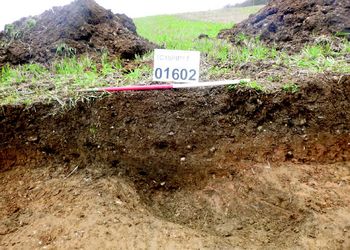Data from a Trial Trench Evaluation at Piper's Wood Cottage, Little Missenden, Buckinghamshire, 2020 (HS2 Phase One)
High Speed Two Ltd., INFRA Archaeology, 2024. https://doi.org/10.5284/1119046. How to cite using this DOI
Data copyright © High Speed Two Ltd. unless otherwise stated
This work is licensed under a The Open Government Licence (OGL).
Primary contact
High Speed Two Ltd.
2 Snowhill
Queensway
Birmingham
B4 6GA
United Kingdom
Tel: 08081 434 434
Resource identifiers
- ADS Collection: 4427
- DOI:https://doi.org/10.5284/1119046
- How to cite using this DOI
Introduction

This collection comprises a digital archive of photographs, GIS files, reports and scanned site records from a trial trench evaluation by INFRA Archaeology at Piper's Wood Cottages, Little Missenden Vent Shaft and ATS, Buckinghamshire, carried out during March 2020.
The evaluation forms part of Phase One of the High Speed 2 (HS2) rail project, which will involve the construction of a new railway approximately 230km (143 miles) in length between London and the West Midlands. Powers for the construction, operation and maintenance of Phase One are conferred by the High-Speed Rail (London - West Midlands) Act 2017.
Project Summary
The aims of the trial trenching were:
- To confirm the presence/absence, extent and depth of any surviving archaeological remains within the Site
- To determine the nature, date, condition, state of preservation, complexity and significance of any archaeological remains
- To determine the nature of the geophysical anomalies identified on the Site and, where archaeological, determine whether they are prehistoric, Roman or medieval in date
- To determine the likely range, quality and quantity of artefactual and environmental evidence present and suggest measures, if appropriate and feasible, for further archaeological investigation to mitigate identified significant impacts.
The trial trenching also sought to contribute to the delivery of the following GWSI HERDS Specific Objectives:
- KC36: How were medieval and later woodlands managed and exploited and what evidence do they preserve for earlier land use?
- KC40: Identify patterns of change within medieval rural settlement from the 11th to mid-14th century
- KC49: Ground truth and develop multispectral and LiDAR prospection techniques
Of the 22 trenches excavated, none revealed archaeological features, and two revealed natural features: a tree throw and a tree root bole. The results of the trial trench evaluation did not uncover evidence of agricultural use, nor evidence of occupation of exploitation of the Site from any period, although the recovery of Roman and Medieval to Post-Medieval CBM from across the field suggests buildings from these dates within the vicinity, but this is uncertain due to the finds being disassociated from their original contexts.
Due to the scarcity of archaeological features across Site and the paucity of artefactual remains, the Site has no potential to contribute to the research objectives set out in the GWSI HERDS and no further work is recommended. Regardless, the archive presented here would be beneficial to any future research or interventions in the region.
Reuse Value Statement
No archaeological remains were revealed during the trial trench evaluation, with only two undated tree-throws revealed to the east of the centre of Site. Previously available data suggested the Site had been in agricultural use since at least the medieval period with no evidence to suggest any earlier features within the Site boundary. The results of the trial trench evaluation did not uncover evidence of agricultural use, nor evidence of occupation of exploitation of the Site from any period, although the recovery of Roman and Medieval to Post-Medieval CBM from across the field suggests buildings from these dates within the vicinity, but this is uncertain due to the finds being disassociated from their original contexts.
Due to the scarcity of archaeological features across the Site and the paucity of artefactual remains, the Site has no potential to contribute to the research objectives set out in the GWSI HERDS and no further work is recommended. Regardless the archive presented here would be beneficial to any future research or interventions in the region.






